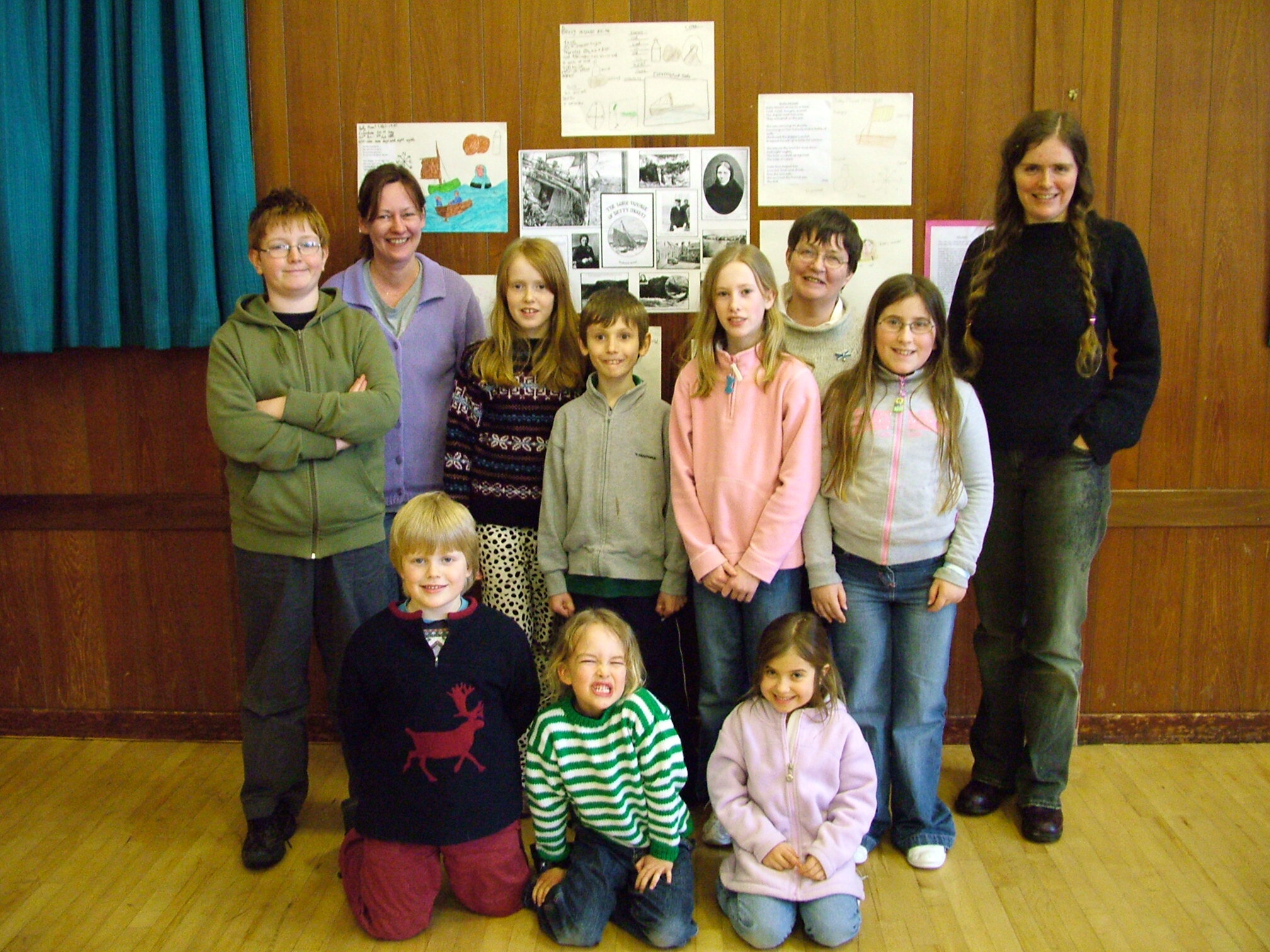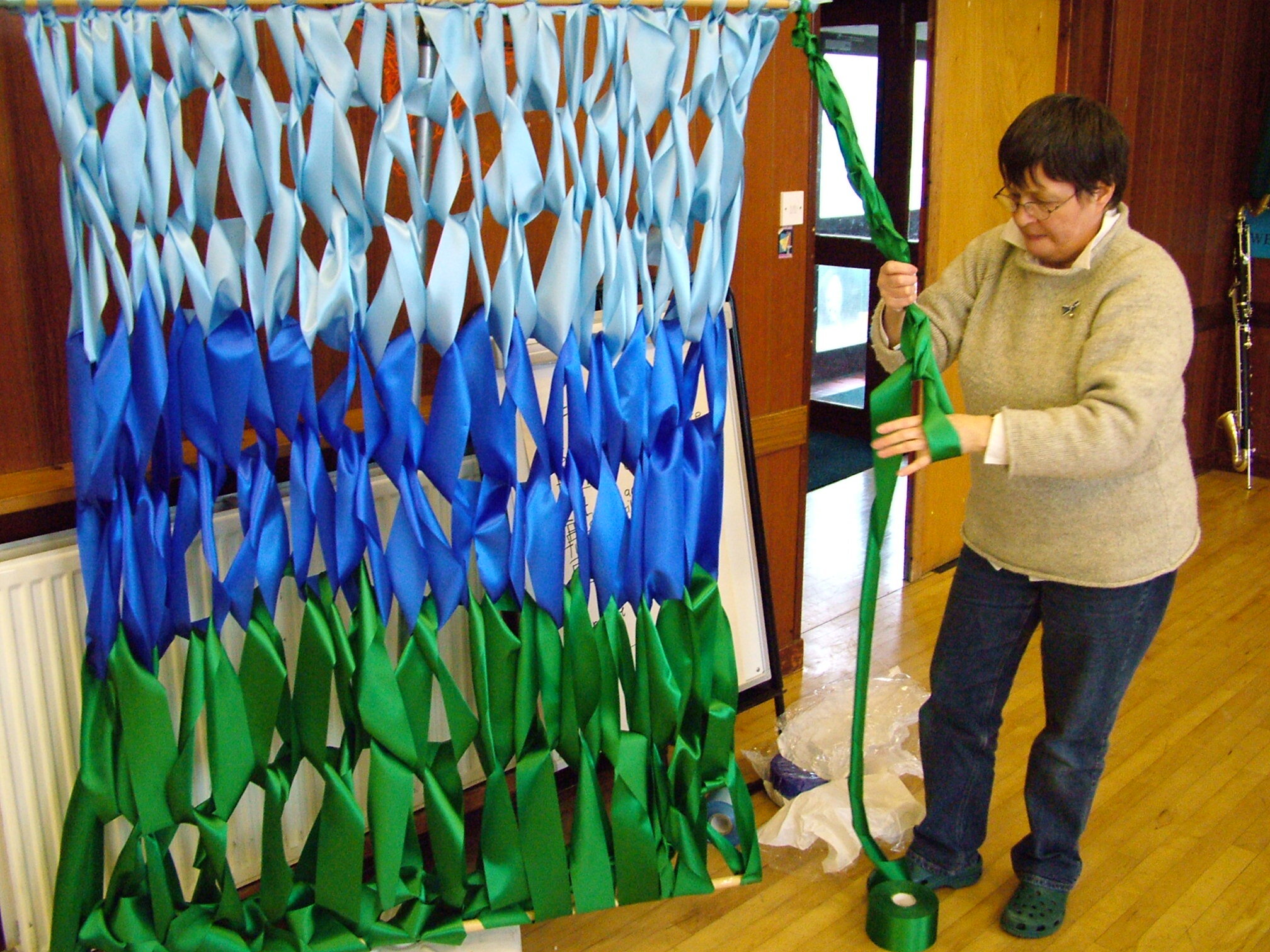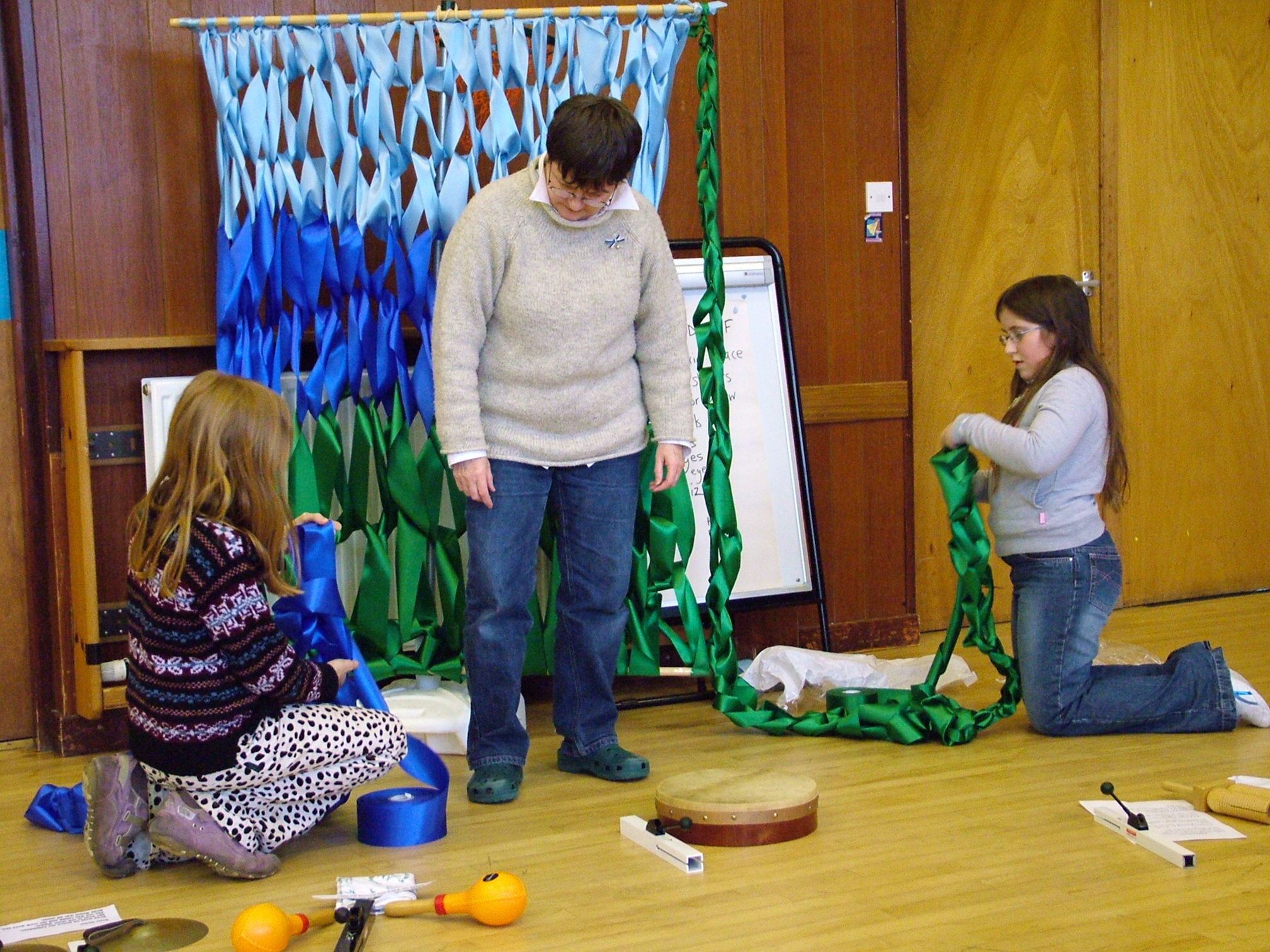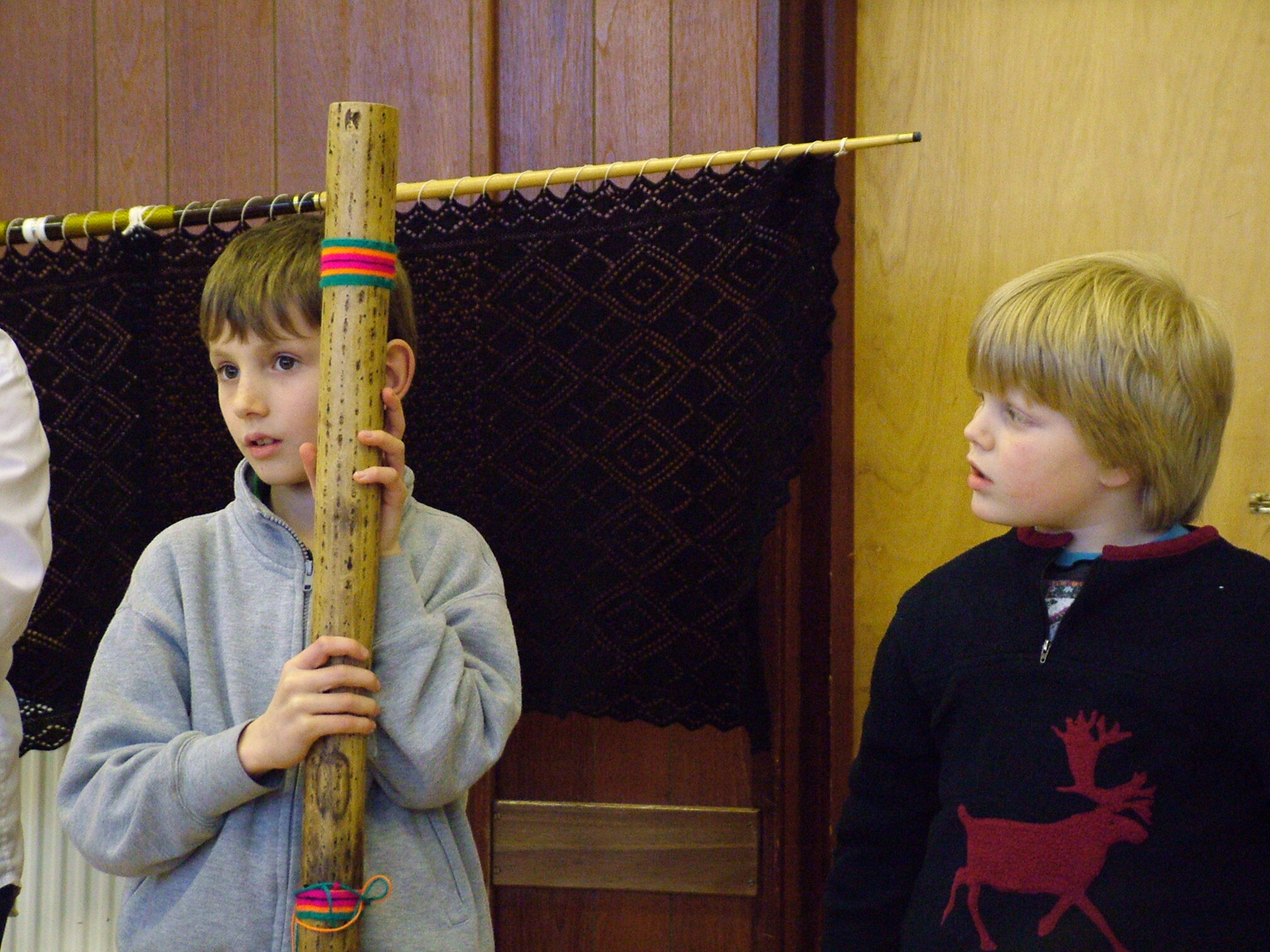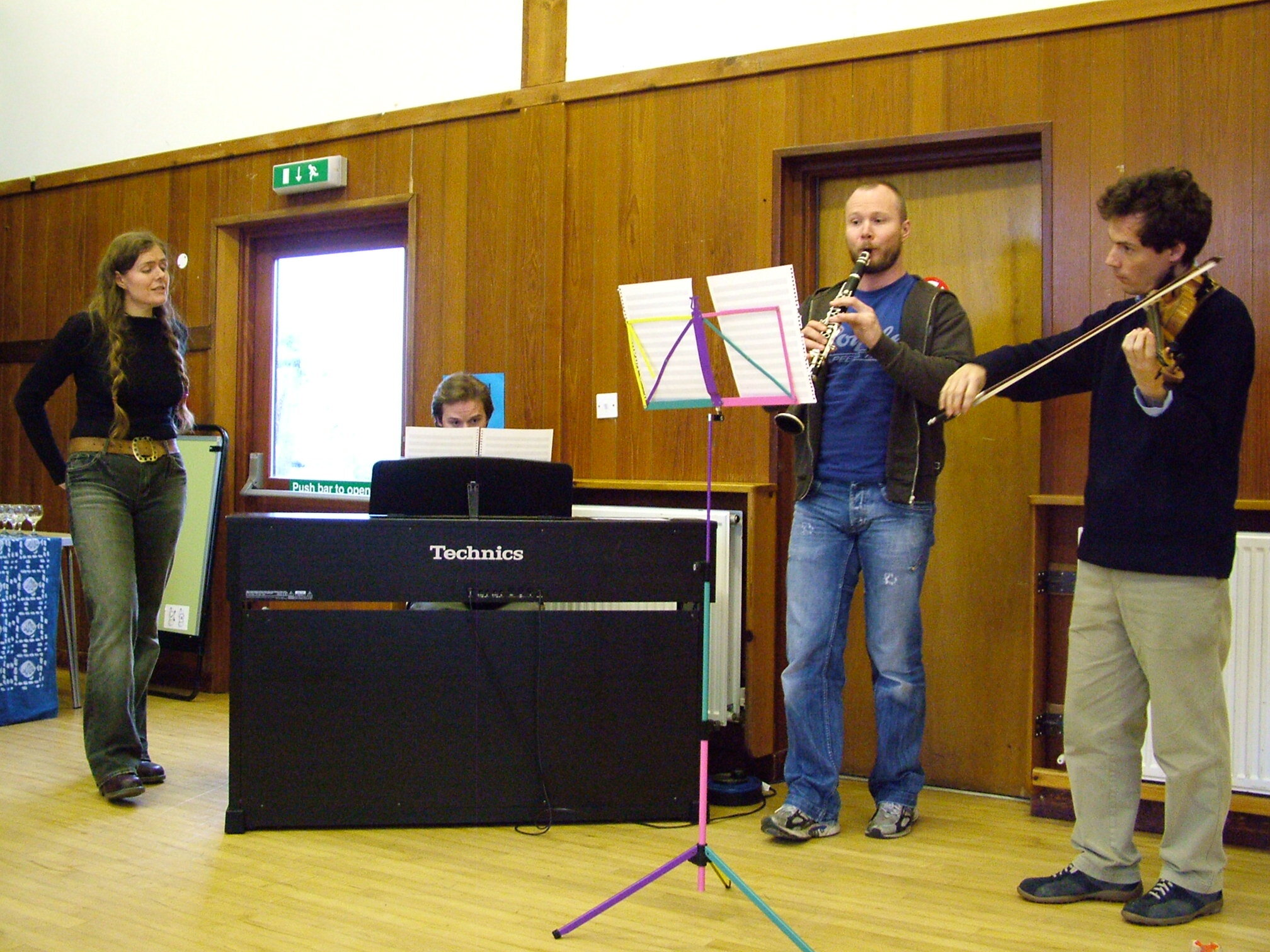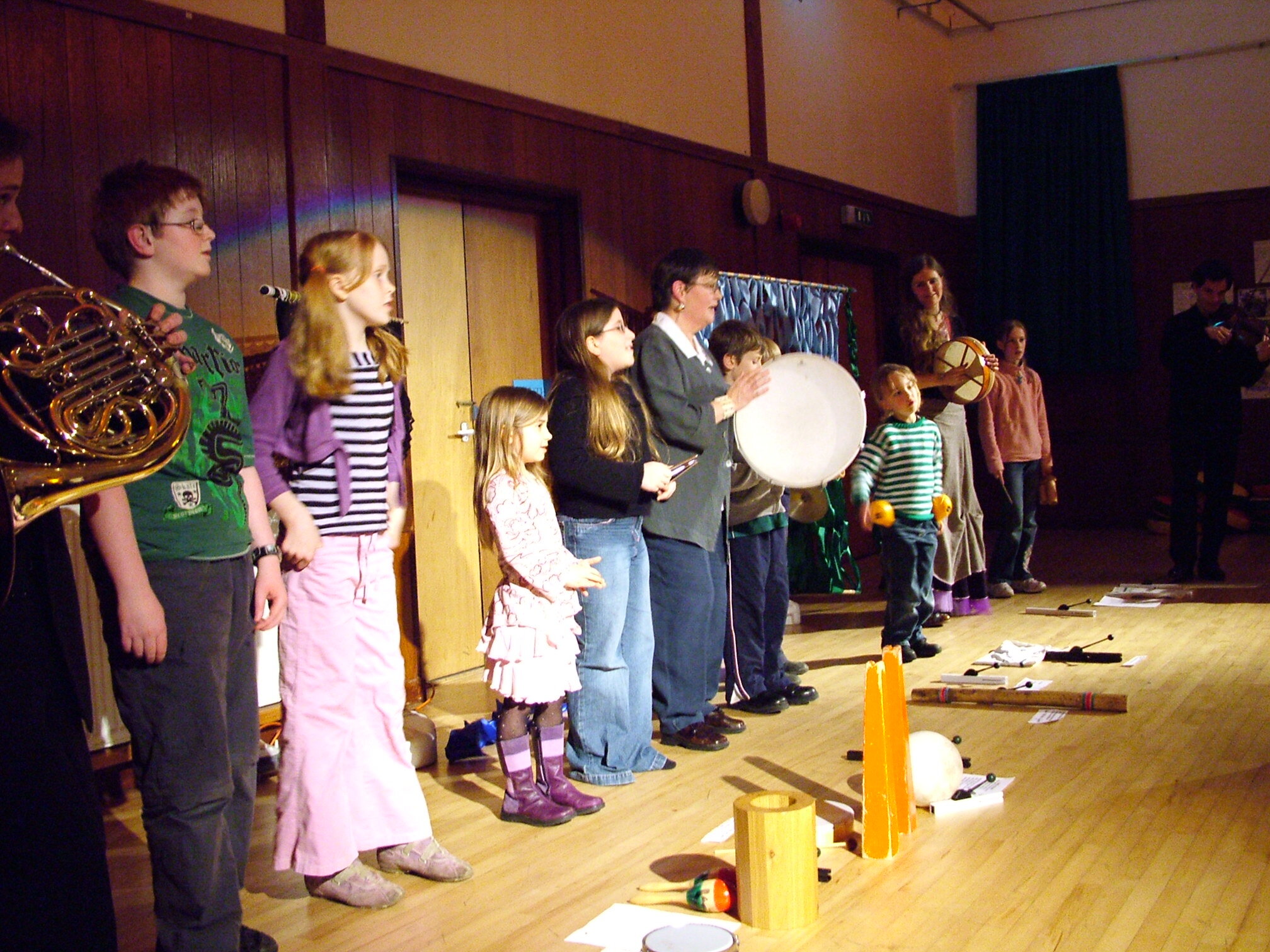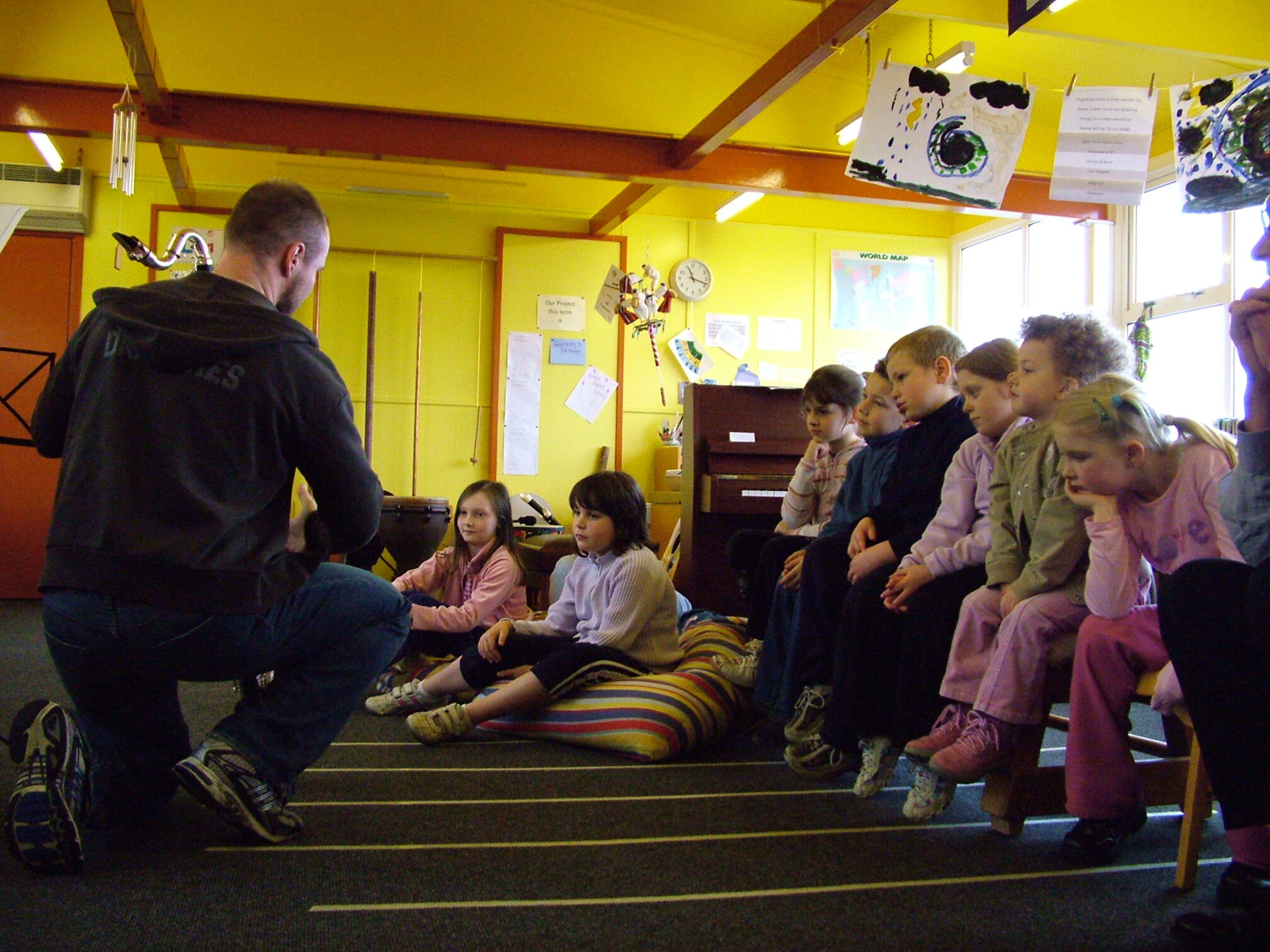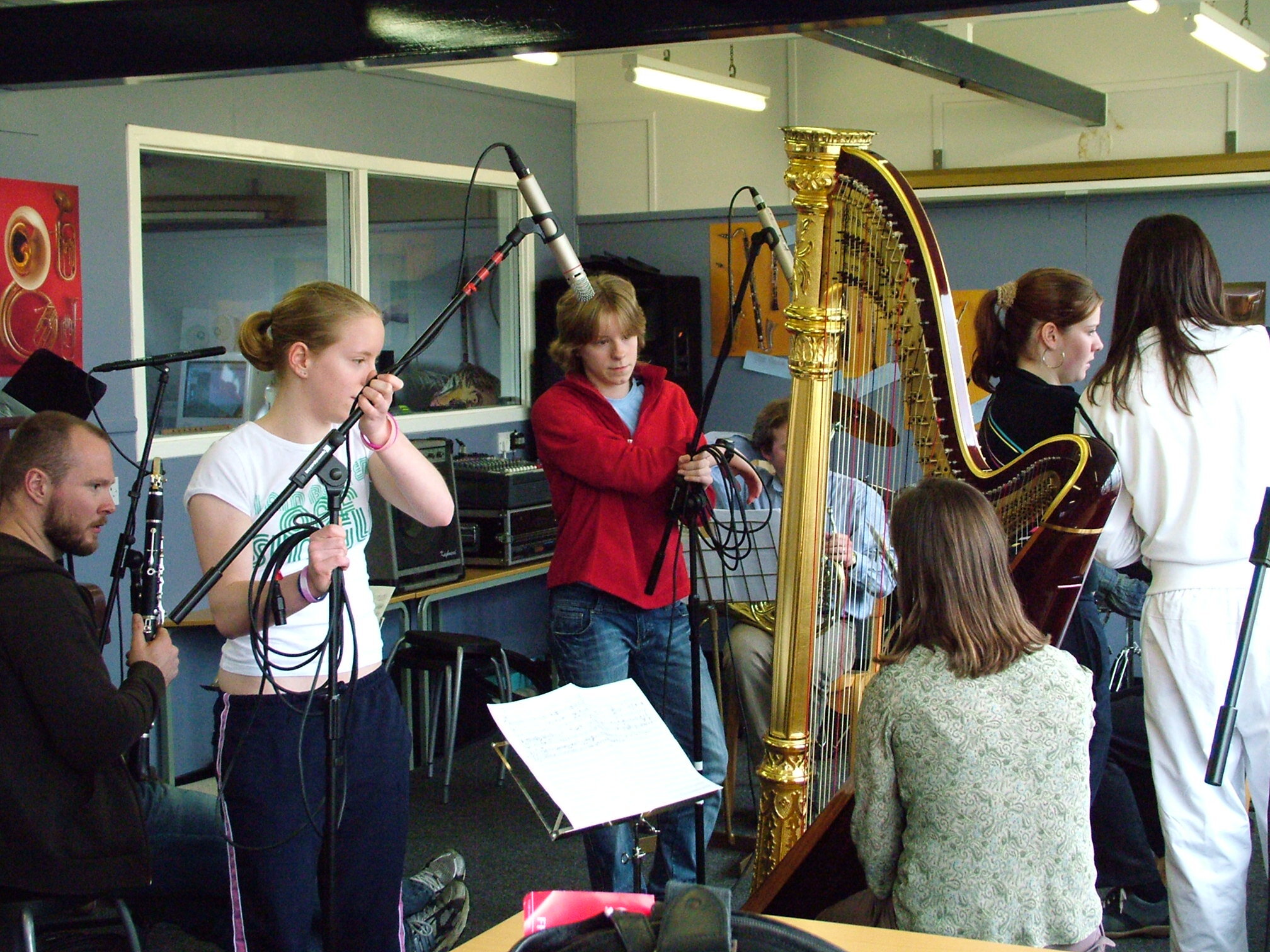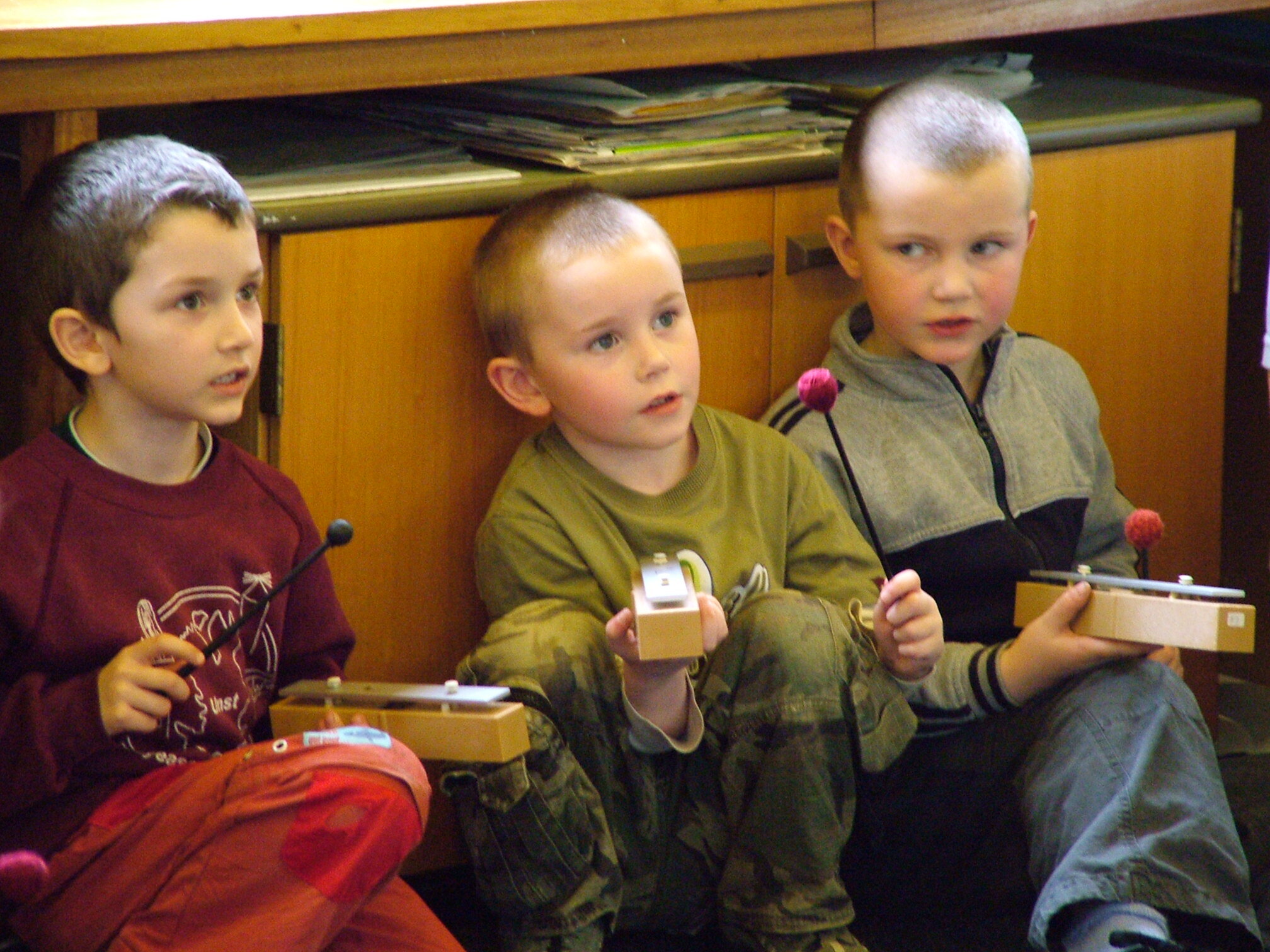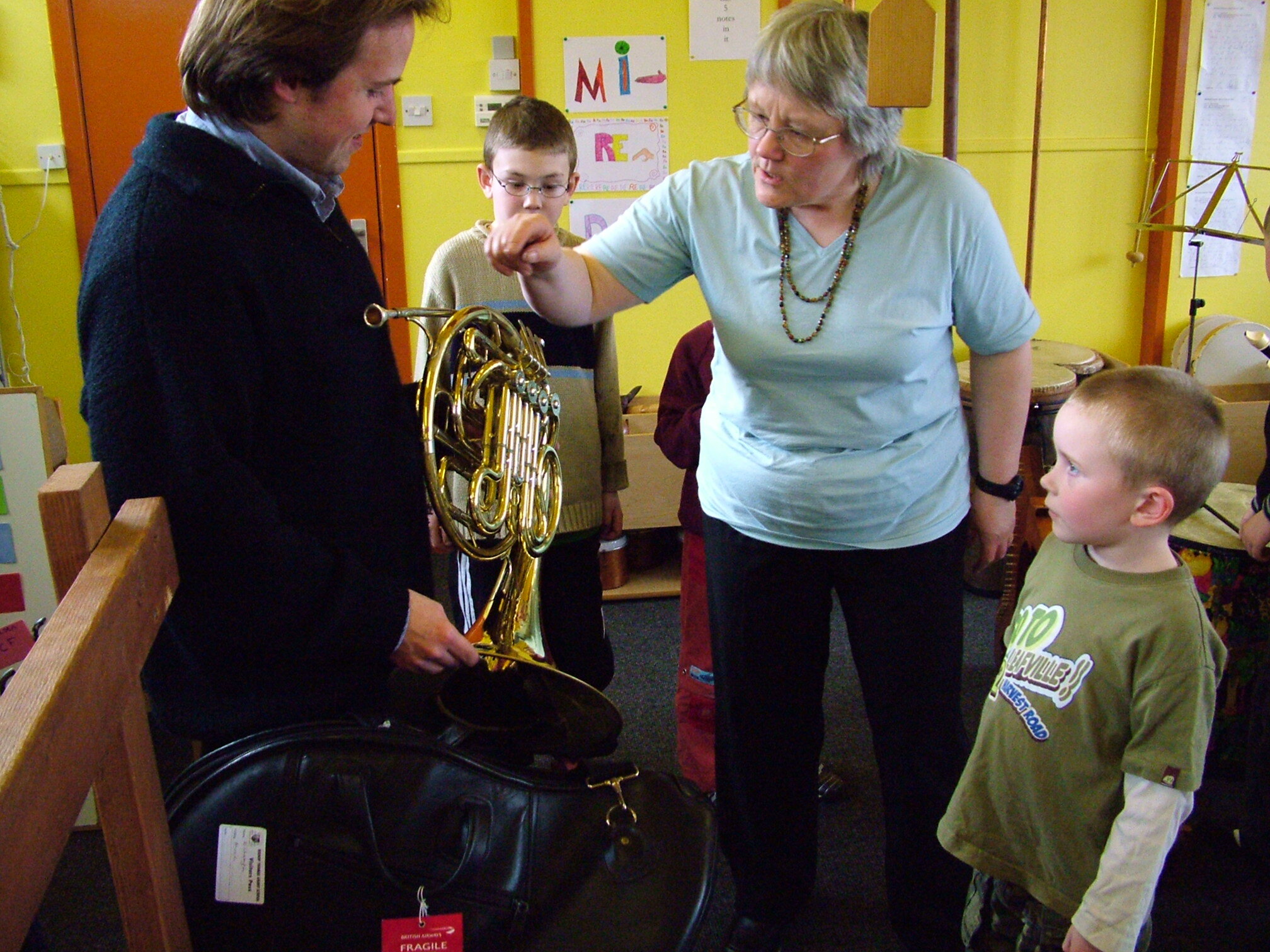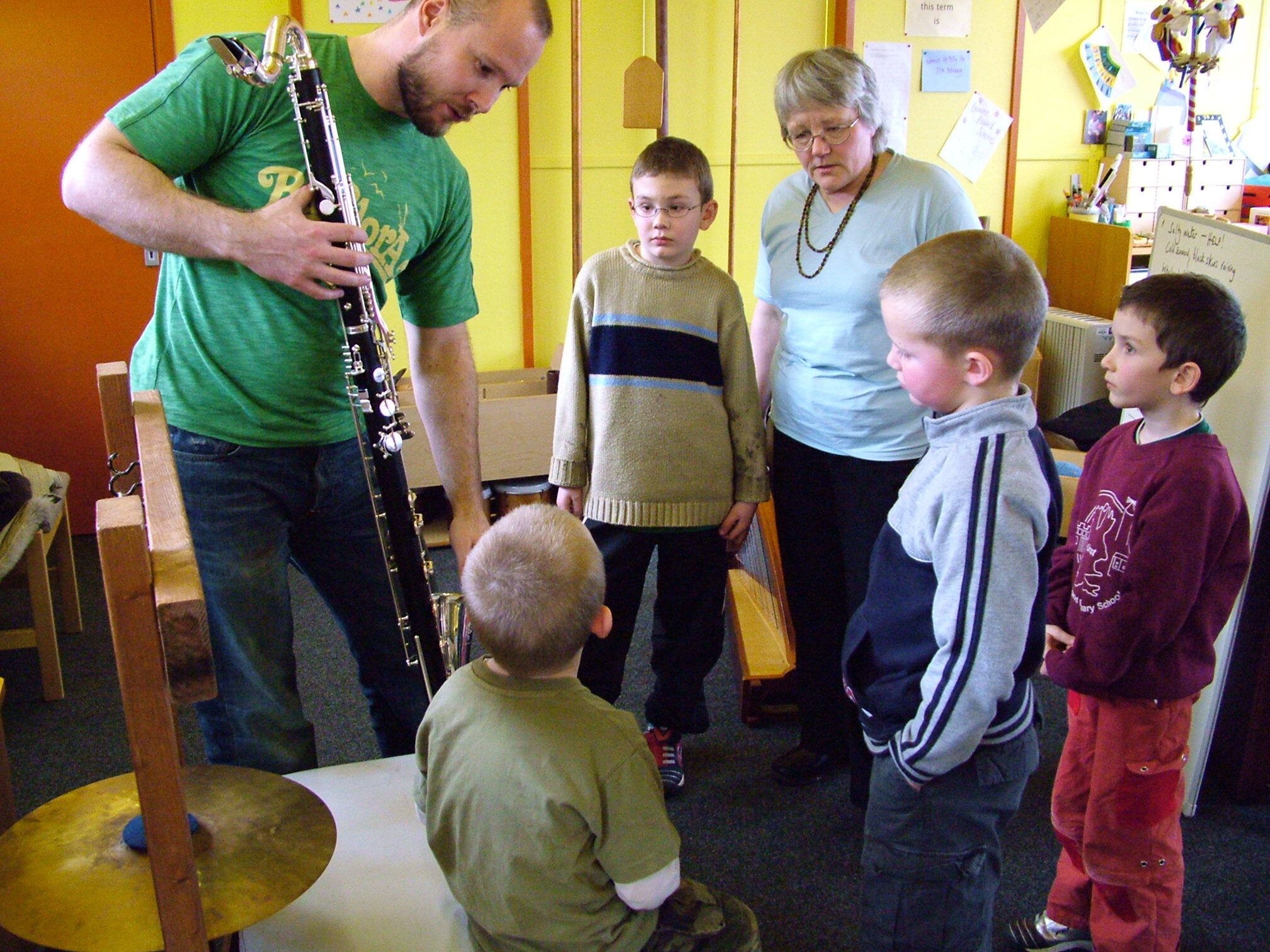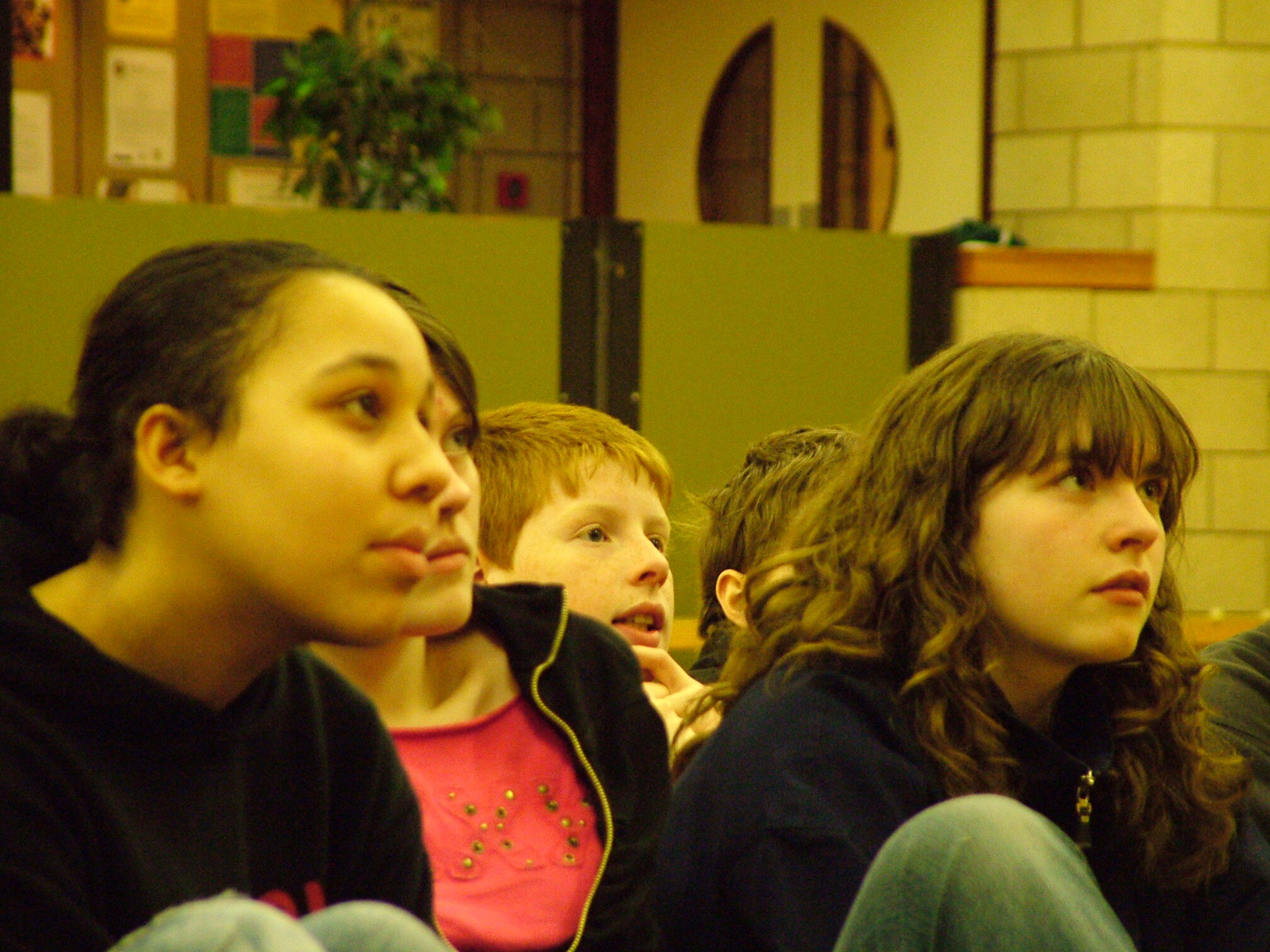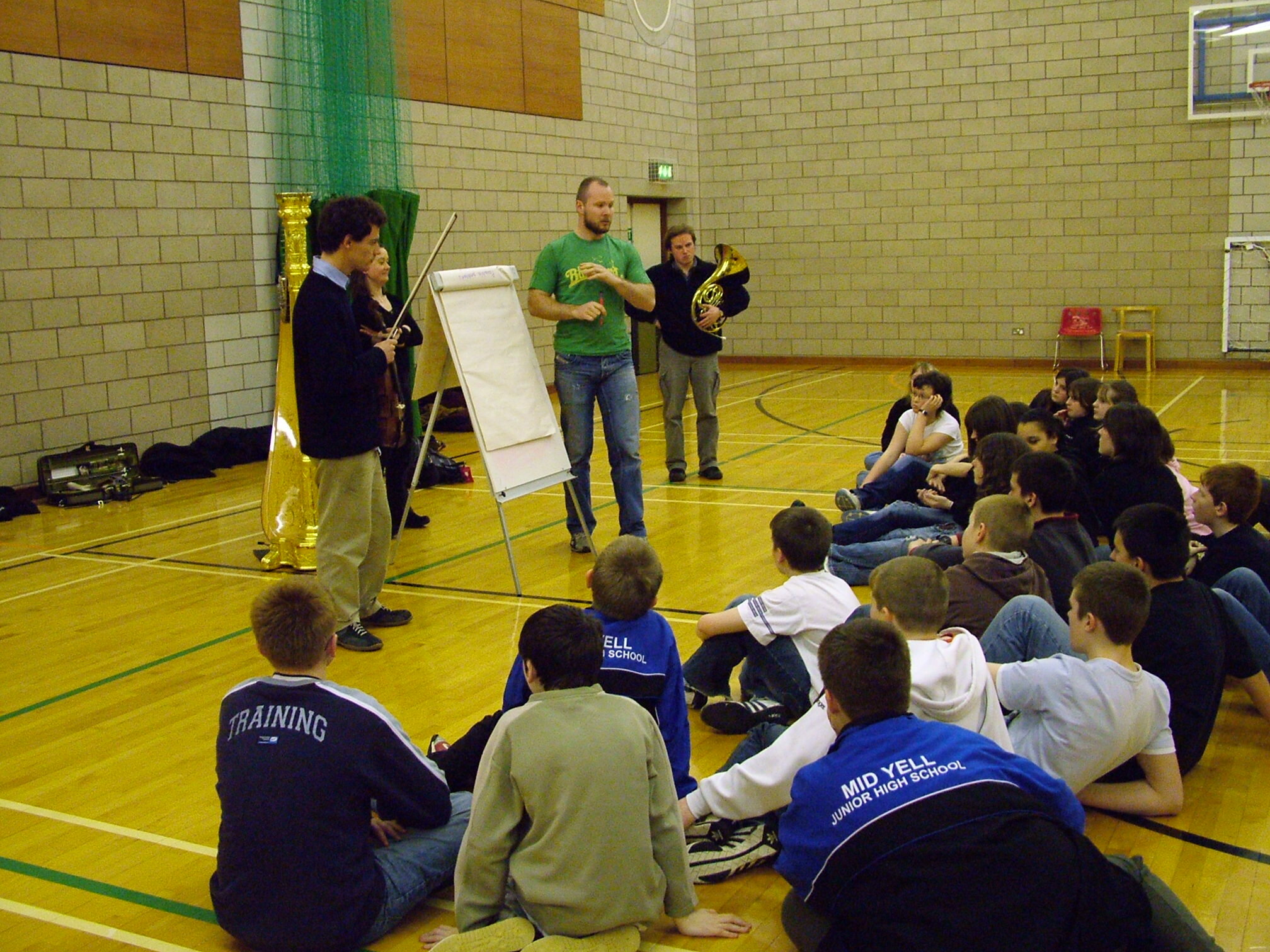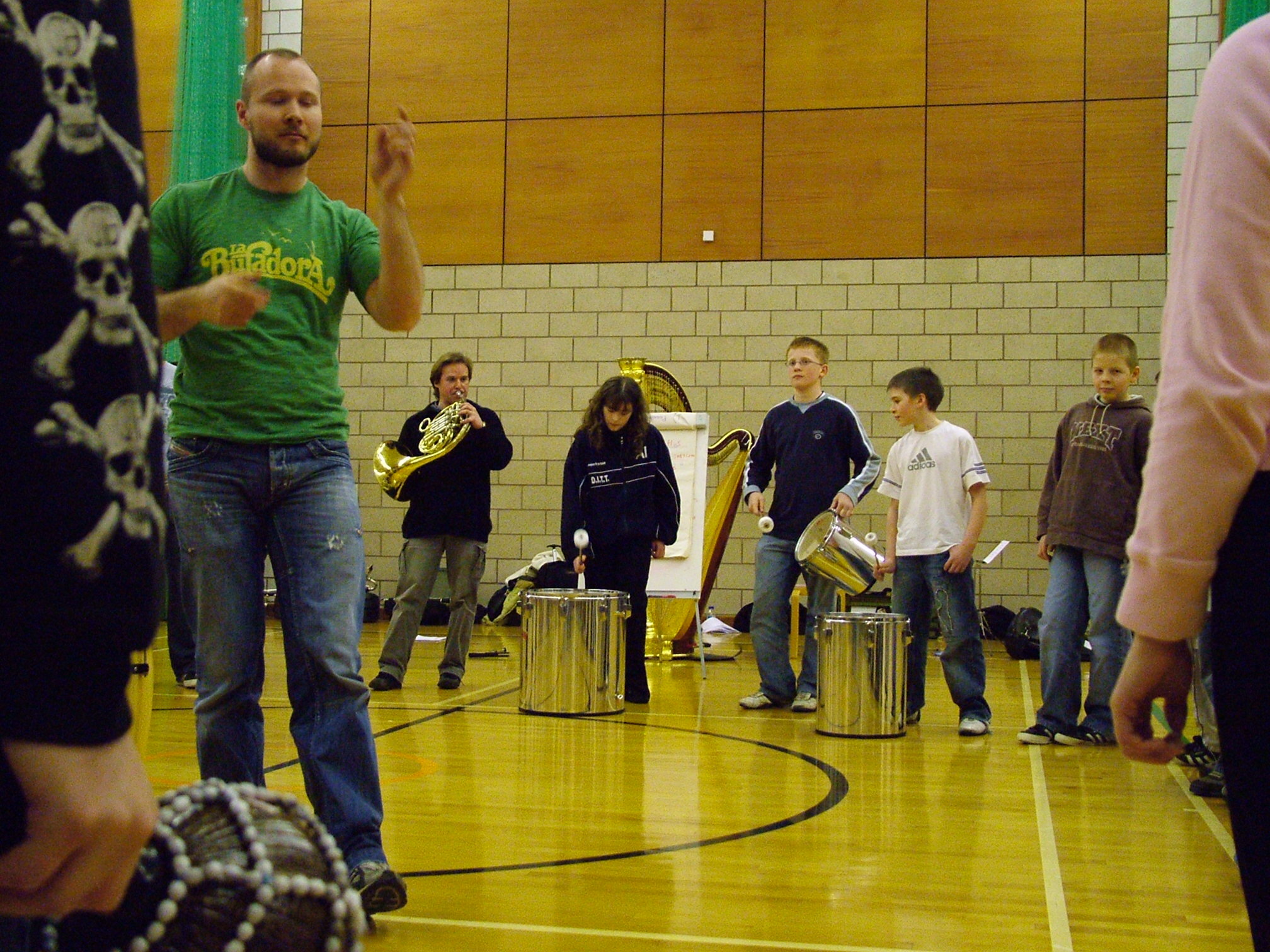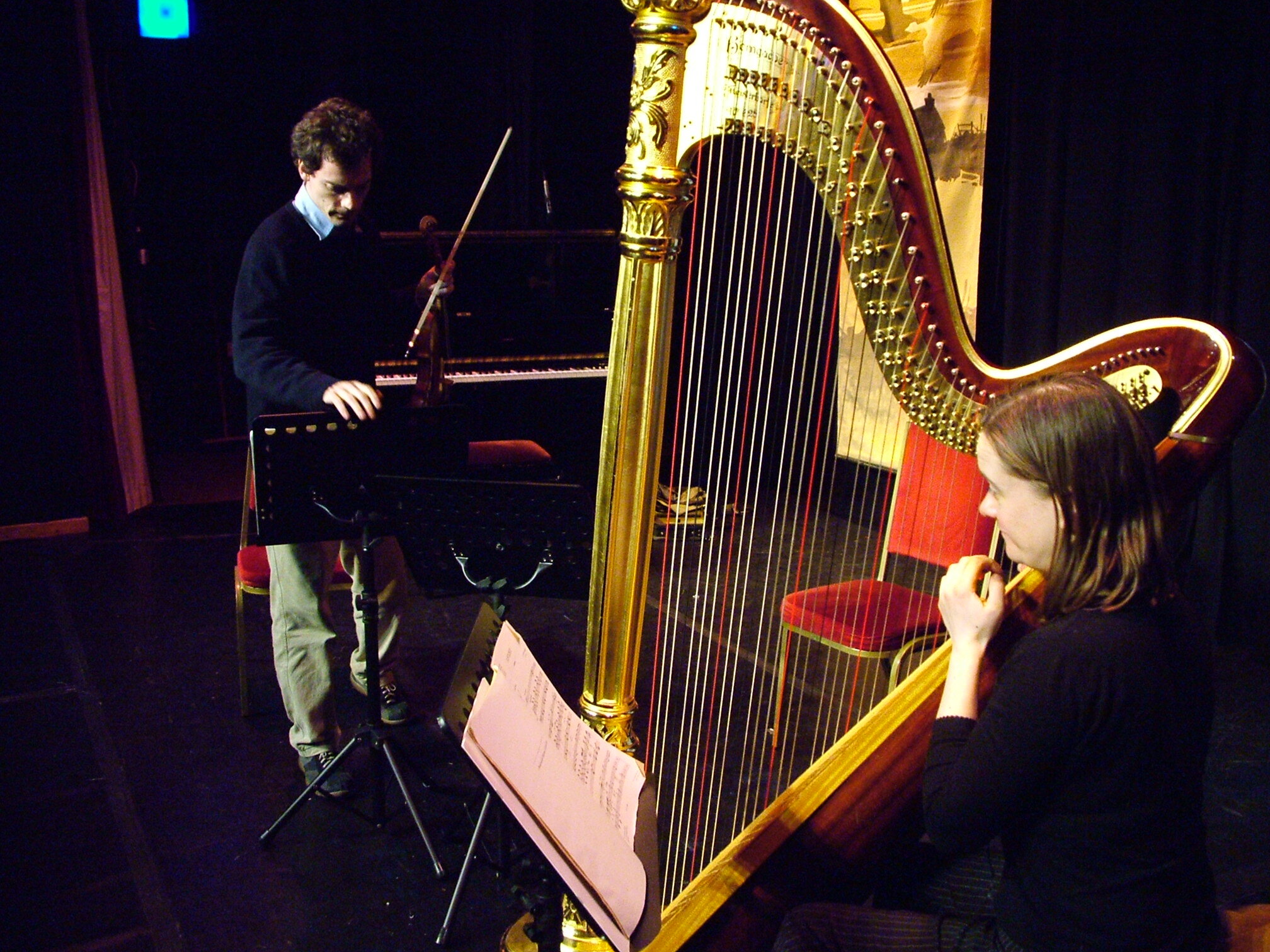SHETLAND ODYSSEY
Tête à Tête’s production of Odysseus Unwound, music by Julian Grant, words by Hattie Naylor, directed by Bill Bankes-Jones, was shaped and inspired by the knitters and spinners of Shetland.
The production toured the UK and Norway, then came home to Shetland. Throughout the tour CHROMA ran a series of workshops tailored for different groups taking material from the opera, involving primary age children, secondary age students, students at university and those early in their performance careers.
In Shetland the workshops ran in schools throughout the islands, in Unst (including children from Fetlar), Yell and Fair Isle. We visited with the Odysseus material twice, in March and in November/December 2006.
SCHOOLS WORKSHOPS
The Shetland Odyssey schools workshops in Shetland were designed to inspire children to pursue their own musical path – to ground them in the basics of music making, and provide them with access to professional musicians who can guide and encourage them.
The workshops aimed to enhance the children’s composing and writing skills, and also stimulate their interest in the traditional local crafts of knitting and spinning, as they see these craftspeople in a new context.
Homer’s Odyssey is rich in source material, and resonates strongly for the communities on Shetland, with its geography, and a hero island-hopping his way home.
The schools programme involved each school group developing its own interpretation of an episode from Homer’s Odyssey, such as Odysseus and Polyphemus, or the Sirens, or Calypso, with each group working towards a performance of these pieces. Fair Isle School was involved in the 2005 development workshops for the opera and already knew the material well, so with them we staged a different voyaging story - of Betty Mouat.
The children also wrote their own words, and explored drama as well as new applications of the traditional local craft of knitting. The workshops explored this fusion of creative forms, in parallel with the opera itself.
While preparing the project content, Claire asked the teachers of the island schools if there was anything we could bring, that they might not otherwise have a chance to see or teach. Requests came back for a full-size concert harp and a French horn, as the islands had never met these instruments in real life. So these were duly added to the team lineup - and were an astonishing success, with many of the children making the harp and French horn the studies for their thank you artworks.
Education Teams
24-30 March 2006:
Stuart King – clarinet
Evgeny Chebykin – horn
Marcus Barcham-Stevens – violin
Helen Sharp – harp
Claire Shovelton - manager/chronicler
Anne Sinclair - knitter
SCHEDULE
Fri 24 - Sat 25 March - FAIR ISLE Fair Isle Primary School
Tues 28 March - YELL Burravoe Primary School, Cullivoe Primary School, Skerries Primary School, Out Skerries
Wed 29 March - YELL Mid Yell Junior High - primary, Mid Yell Junior High, juniors
Wed 29 March - LERWICK evening CHROMA concert at Garrison Theatre
Thurs 30 March - UNST Baltasound Junior High School, Uyeasound Primary School, Fetlar Primary School
November/December 2006:
Stuart King – clarinet
Marcus Barcham-Stevens – violin
Emma Feilding - oboe/cor anglais
Bill Bankes-Jones - director of Odysseus Unwound
Claire Shovelton - manager/chronicler
Lise Sinclair - poet/musician
Margaret Peterson - knitter/spinner
SCHEDULE
Mon 27 Nov – 19:30 Odysseus Unwound performance Clickimin Centre Lerwick
Tues 28 Nov - YELL workshops AM Mid-Yell Primary PM Mid-Yell Juniors
Wed 28 Nov - YELL workshops AM Mid-Yell Juniors PM Burravoe/Cullivoe Primaries
Thur 29 Nov - UNST workshops AM Baltasound Juniors PM Uyeasound/Baltasound/Fetlar Primaries
Fri 1 Dec - FAIR ISLE PM Fair Isle School
Sat 2 Dec - AM Fair Isle School, PM rehearsal EVE CHROMA concert
Sun 3 Dec - Fair Isle social
Shetland Odyssey workshops March
Journal by Stuart King
PROJECT ONE – FAIR ISLE SCHOOL
Children:
Scott Mitchell, Alice Best, Lowri Best, Erin Welsh, Amy Stout, Melissa Welsh, Fyntan Shaw, Oliver Harrison
Adults:
Ruth Stout, Lise Sinclair, Anne Sinclair, Gillian Harrison
Instrumentalists:
Marcus Barcham-Stevens – violin, Evgeny Chebykin – French horn, Stuart King – clarinet
Manager/Chronicler: Claire Shovelton
DAY ONE (session one):
Following a real modern day Odyssey to reach Fair Isle involving a cancelled flight, a missed connection, unscheduled overnight in Aberdeen and gales threatening to ground us on Shetland CHROMA overcame all obstacles and managed to arrive on Fair Isle in time for the end of school on a Friday.
Such was the excitement and anticipation of the eight Fair Isle children that they were willing to sacrifice not only their after-school time on a Friday, but the whole of their Saturday to work on their rendition of a local Odyssey story about a Shetland knitter, Betty Mouat, who was left stranded and alone on a ship following a ferocious storm and washed up in Norway after nine days.
The first session began with introductions of the visiting musicians and demonstrations of the instruments, which clearly delighted the youngsters, many of whom had never before seen a french horn or a bass clarinet. Two of the musicians had visited the island before so it was a pleasure to see some of the children again.
After all questions about the instruments had been answered, the children delighted in recounting all the details of Betty Mouat’s fascinating story, overcoming tremendous odds to survive such a disaster. The musicians learned a great deal of extra detail about Betty’s life from the children, apart from the shipping disaster and it was brilliant to begin a project sharing in this way.
Sitting in a circle we all introduced ourselves, any instruments that we each played and our favourite foods before starting with warm-up games, designed to warm-up bodies and voices in preparation for singing.
The first task for the children was to teach them a short extract from the Tete-a-Tete Opera of the Odyssey by Julian Grant, which had been workshopped on Fair Isle in October of 2005. The Sailor’s Song, whilst tricky to master was a perfect jumping off point to the story and an important link between this education visit, the previous opera workshops and the forthcoming premiere of the opera in the Autumn of 2006.
The children made a very good effort and learning the Sailor’s Song and were given the words to take home with them that night.
The children were also introduced to a way of generating notation. This utilizes the German notational nomenclature (A-B-C-D-E-F-G-H-S), where B=B flat; H=B natural and S=E flat. In this way notation can be created from words and the children’s names can be turned into musical signatures. The results are always interesting and serve as an very simple and useful tool for teachers and children.
Using this process the CHROMA musicians could play their own names and introduce the children to the musical phrase produced from conjoining FAIR ISLE SCHOOL and BETTY MOUAT. This musical phrase is really successful and would be used as the basis for the opening section of the children’s piece.
Ex.1 (FAIR ISLE SCHOOL BETTY MOUAT) when conjoined translates into the following musical phrase:
(F – A – Eflat – Enatural – Eflat – C – B natural - Bflat – E – A)
DAY TWO (session two):
The storm that threatened to prevent us from flying into Fair Isle raged all through the night and the next day dawned with no sign of the storm abating. We couldn’t have wished for a better backdrop for our exploration of Betty’s Odyssey with the wind howling and whistling around the Community Hall.
The second session with the children began with the traditional warm-ups, which consisted of rhythm games and vocal warm-ups where the children pretend to be motorbikes and bumble-bees amongst other things. This is all great fun and an excellent preparation for singing through the tricky tune of the Sailor’s Song ‘Splice the Main Brace’ from the Opera. The children got to grips with the words and tune really well this time, so we were able to introduce actions to go with the words of the song.
Next we developed the idea of generating notation from the name of the school and our heroine to create a melodic palette from which both melody and harmony can be created.
Fair Isle School has a fantastic selection of classroom percussion including a full set of hand chimes. Taking the notes from (Ex.1) we gave each of the eight children and two of the adults a hand chime bar to correspond with the notes in our ‘fair isle tone row’. The first task was to practise ringing the chimes one after the other to form the introduction to our composition – a musical introduction of the school and our heroine Betty. The children quickly mastered this and the sound was terrific. Because the sound produced by the chimes and the particular pitches generated was so successful we decided to develop this section further.
Firstly we asked the children to think of a number between one and eight and to only play their hand chime on that number when it was called out. In this way interesting chords and occasional silences are created. The next step was to pick two different numbers from one to eight and repeat the exercise. The result is like a ring of church bells with some wonderful dissonances – a sound the children and adults clearly enjoyed a great deal. This was a perfect way to begin our work.
After a quick break it was important for us to share the work the children had been preparing before our arrival. In all the projects we had asked the teachers to prepare an element in advance. In this case the children had studied Betty’s story and firstly produced creative writing about Betty’s time stranded alone on the Columbine with only a quart of milk and two biscuits for nine days and nights.
The children’s work was brilliant and we were keen that they should each read out their work as part of the drama of their composition. In addition the children had worked with their music teacher Lise Sinclair on a musical soundscape to represent the terrible storm in which the Columbine’s main boom broke, sails ripped and men were swept overboard. The children had produced an amazingly imaginative and evocative section of music. This involved damp tea-towels to represent the violent flapping of the sails, a multi-faceted wooden barrel and a heavy ships float which when rolled between two children across a wooden floor produced an fantastic rumbling sound. There were also heavy wooden posts, which could be knocked over repeatedly at random to produce terrifying snapping sounds. Added to this were cymbal crashes, a rain-stick and deep drums.
We worked on this section a few times, perfecting it, giving it more shape and choosing one of the children to lead the beginning and end of the section. The end result was excellent, starting with faint spatterings of rain on the drums and the rain-stick doing its job before gradually introducing the other elements as above, crescendoing to a deafening and apocalyptic climax and fading away again to leave the rain-stick and the dripping drum rain.
The children were now put through their paces reading out their own poems and creative writing each in turn. After the understandable initial trepidation they all soon warmed to the task and with encouragement were becoming clearer in diction and more confident. A good time to take lunch.
(session three):
The final element of the composition that needed to be workshopped was the grand finale, which would take the form of a samba band percussion element over a groove and a rap to finish off Betty’s story. The warm-up for the samba session built upon earlier rhythmic warm-ups, which introduced the idea of building up a complex rhythmic polyphony from simple individual rhythm cells where each child plays a different short and simple riff from each other. The result is very satisfying and easily achieved. By putting this over a simple bass line groove taken from the ‘fair isle tone row’ it was a great way of introducing Betty’s Rap, which was a call and response section designed to be audience-participatory in the final performance.
Now all the musical elements had been covered and the last thing we needed to work on was the knitting element, an integral part of the opera project and central to the focus of working with the Shetland and Northern Isles communities.
Our resident knitting artist Anne Sinclair had already produced a stunning backdrop to our nautical tale – two ships sails; one created from sewing a traditional woollen shawl (similar to the forty shawls Betty was taking to sell on the Shetland Mainland when her vessel was crippled) onto a snooker cue, the other fashioned in big knitting loops using sea-coloured ribbons, which we brought with us, again between two snooker cues.
It is important that the children be involved in an element of knitting or weaving as part of the project and Anne came up with the brilliant idea of showing the children how to weave a rope for the ships rigging by hand-looping the wide coloured ribbons. This element was introduced into the section where the children take it in turns to read out their creative writing. After each child stands up and reads they move to the knitted ribbon sails and produce a length of woven ribbon rope which on two sides which is then passed on to the next child once they have finished reading. This results in a fantastically lengthy pair of sail ropes created in real time by the children.
The rest of the session was spent honing, perfecting and rehearsing the composition to make it ready for the performance in the evening to the rest of the assembled community.
The Fair Isle School Story of Betty Mouat composition was performed as follows:
Section 1: Long quiet pedal note F played by very low by French horn and very high by the violin to create a still and calm opening. The children and adults play the ‘Fair Isle School Betty Mouat tone row’ through twice over the pedal using hand chimes. This moves into the section of creating a ‘peal of bells’ by choosing two numbers between one and eight and repeating until directed to move to section two. The end of section one is heralded by the introduction of the first few notes of the ‘Sailor’s Song “Splice the Main Brace”’ taken from the Shetland Odyssey Opera by Julian Grant played by the CHROMA instrumentalists.
Section 2: The hand chimes stop and are quietly placed on the floor to enable the children to sing and do the actions to “Splice the Main Brace” (see Appendix for lyrics and actions) with accompaniment by CHROMA musicians. This section sets the scene of getting onboard ship ready for departure. The mode used predominantly in the ‘Sailor’s Song’ is F Lydian (all the white notes on a piano keyboard starting on F), which by chance works perfectly alongside the generated notation from the Fair Isle School Betty Mouat’ tone row. The link from section two to the following storm section is undulating improvisation using F Lydian mode.
Section 3: The storm section created in advance by the children is led by Oliver Harrison in charge of the rain stick. This precipitates the storm, beginning with patterings on deep drums before each child introduces his/her element – wet tea-towel sheets, rumbling barrels, crashing beams, thunder-clap cymbals and wild whistling waves on the violin and fog horn calls from the French horn. The section ends when Oliver decides the rains stick should be silenced and so the storm passes.
Section 4: The storm instruments are carefully set down and Scott Mitchell begins the children’s creative writing readings, which tell of Betty’s predicament alone on the Columbine, her thoughts and feelings. After each child finished reciting they move to the woven ribbon sail and being hand-looping the ropes using the coloured ribbons, passing the rope to each child as they finish. The link into the final section is the introduction of the samba groove on the French horn using F Lydian mode.
Section 5: Once the groove becomes established by the CHROMA players, each child introduces his/her rhythmic cell into the mix lead by Scott Mitchell again. This peaks and one-by-one each cell is removed to make way for Betty’s Rap, leaving just the groove and basic drum. The Rap is a call and response with audience particiation, which neatly finished the story. The final line of the Rap is the children’s cue to come in again with their samba groove rhythms all together for a rousing carnival atmosphere ending to the Betty Mouat Story.
APPENDIX:
“SPLICE THE MAIN BRACE” – by Hattie Naylor and Julian Grant
Splice the main brace (rolling arms over each other – like winding motion)
Haul up the Sheets (as if pulling up a ship’s rigging)
Pull the anchor below (dragging the anchor from below)
Hold the tiller (holding the rudder)
Furl up the Sails (pushing up the sails from below above your head)
Fix your eyes (looking into the distance – hand over eyes)
On the horizon (scan your hand slowly from left to right)
BETTY’S RAP – by Stuart King
For nine whole days
And eight whole nights
Poor old Betty
Had some frights
Against all odds!
The ship made land
No other crew
To lend a hand
What shore was this?
What rock-scarred bay?
Not Lerwick town
But far Norway
A hero's welcome
For brave Betty
Who lived to tell
Of her Odyssey!
DAY THREE & FOUR
Due to fog and high winds the planes to and from Fair Isle were grounded. Attempts to reach the island were made but the plane had to turn back to Tingwall. In addition to this there was a ferry-workers strike (something we were told had never happened before) which meant that Helen our harpist, recently arrived on Shetland by boat from Aberdeen, had to drive immediately up to the second most northerly island of the Shetland archipelago, Yell on the Monday afternoon to ensure that she could undertake the workshops as planned; only she would be taking them alone.
Originally the plan had been for us all to meet in Lerwick on the mainland and travel up together to our lodgings on Unst the next day giving a day’s workshops on Yell on the way. Due to the ferry strikes this meant that inter-island travel was impossible. This also meant that the children from Fetlar would also miss the workshops, as they were due to work alongside the children from Cullivoe, Burravoe on Yell and those from Out Skerries who were travelling over by boat before the strike came into effect. Time spent arranging and rearranging travel itineraries, briefing Helen who was delivering workshops in our stead and preparing material for the Mid-Yell & Baltasound workshops.
DAY FIVE – Mid Yell Junior High School
During our forced absence from mainland Shetland Helen, our harpist, had been holding the fort single-handedly and having a fine time making monsters and music with the children from on Yell from Cullivoe, Burravoe and the tiny island of Out Skerries.
By the time we landed on the Shetland mainland and drove north taking the ferry to Yell it was early-afternoon. Helen had already taken a workshop with a very large group of 52 primary school children at Mid Yell school in the morning and had begun introductions to the older children after lunch when we arrived. Helen briefed us as to what she had done with this group in the first session so that I could carry on for the remaining part of the day.
The first part of the session was taken up with brief introductions of ourselves and our instruments. There was some initial shyness at answering our questions even though the children were really quite knowledgeable about what instruments we were showing them and how they worked. This shyness is common amongst children of this age (10-12), where being seen to be clever or have the answers is not cool. Once we got going however this reticence soon melted away.
As this session was going to be quite short it was important to get straight down to business. I explained what we were going to do for the rest of the day; create a short piece of music together with an introduction using elements identifiable uniquely with Mid Yell School Shetland and the story of Circe. The second section would involve some of the children reading out their creative writing work, which had been prepared in advance, about their thoughts on living in a land of luxury. Finally there would be a groove and chorus rap finale, which I would teach them.
Before we began, I quickly explained how we could generate notation from the name of their school Mid Yell Shetland (D – E – Eb – Bnatural – Enatural – A – D) or indeed they could work out their own names. I also introduced the motifs that we could use in our composition based on the Circe story from the Odyssey, namely Circe herself (C – C – E) and the isle of Aeaea (A – E – A – E – A).
It was time to begin and we handed out carefully selected percussion to each child; chime bars tuned to the notes generated by their school name and other samba band percussion for the finale. There was some trepidation by the teachers that mayhem would ensue but thankfully the children conducted themselves immaculately.
Standing in a big circle we began with rhythmic coordination practice. Each child played their percussion instrument in time to a beat. Then we practised playing exactly together as a group using a karate chop visual cue, which was swiftly mastered by everyone. We then tried creating an introduction to our composition using the ‘numbers from one to eight’ technique so successful in Fair Isle. This worked very well with a larger group as well and had a particularly unique sound with the mixture of percussion available and the dissonances created by the generated notation.
Once everyone had settled into playing only on their two numbers of choice, I introduced the concept of following signals for increasing and decreasing the volume. They followed this brilliantly, which meant that we could move seamlessly into the spoken section with a gentle accompaniment provided by both CHROMA players and some of the children.
We spent some time listening to the four children read out aloud their writings about ‘luxury’, which had been chosen at random from the excellent selection of work prepared in advance. With encouragement they all spoke well, clearly and without too much shyness. Each poem captured the character of the individual nicely and they had all obviously thought carefully about the subject matter, indeed some of their ideas were really thought-provoking.
The next section of the composition was the groove and samba-rhythm part. This began with our horn player Evgeny introducing a groove based on the Aeaea notation, which created a very useful tonic-dominant bass line. Added to this Marcus and Helen on violin and harp improvising with the implied tonality of A minor once the Circe derived notation was added in to the mix. Three children were selected as ‘beat-keepers’ and allocated deep drums and djembes.
Between them they each came up with a different rhythm that together kept a very funky, and more importantly, steady beat going. In turn each of the other children entered the fray with their own rhythm, which could be simple or complex – the sound when everyone was in together was fantastic. I introduced the idea of selecting some players as soloists who would carry on playing when I indicated to the others to stop, thus highlighting interesting mini-ensembles within the group as a whole. The children quickly picked up on the signals and gestures necessary to bring people back in, stop temporarily and listen to soloists, play louder or softer and thus become a small percussion orchestra.
The final section to go through before piecing everything together was to go through the ‘Circe Rap’ that I had prepared for them in advance. As in Fair Isle this took the form of a call and response chorus and nicely brought in elements from the original story of the witch Circe turning Odysseus’ men into pigs and keeping them in captive luxury for more than a year.
CIRCE’S RAP – by Stuart King
On the isle
Of Aeaea
Lives a witch
Who many fear
Her loathsome spells
Turn men to pigs
Who gorge themselves
On wine and figs
Held captive so
They cannot flee
Back to their homes
Across the sea
So do beware
And hear our plea
Sail past the isle
Of Circe!
DAY SIX – Baltasound, Uyeasound and Fetlar
Glorious blue skies and warm spring sunshine sped the CHROMA team northwards to Baltasound Junior High School, where we were to conduct our final day of workshops. We had already briefly met the fantastically organised and dynamic music teacher of Baltasound, Alice Mullay, on the ferry the previous evening on our hasty run south to fulfil our postponed concert engagement at the Garrison Theatre in Lerwick on the mainland.
Alice and her partner Jonathan’s work with the children is an inspiration to all music teachers. A production of the Odyssey had been staged, filmed, composed and performed by the children under their guiding hand for the Christmas Production. The DVD of the project so far is brilliant and thrilling to see how all the children have embraced the Odyssey story and had great fun recounting it in their own words – all this from the initial spark ignited by the Tête-à-Tête Opera project coming to Shetland.
Alice had created a blistering schedule, which would make it possible for all the children in school and the visitors from Uyeasound and Fetlar to see us at least once. In addition to our own plans for some of the children, we had discussed, in the weeks before the project, the possibility of recording some of the children’s compositions that they hadn’t been able to perform, for inclusion in the final cut of the Baltasound Odyssey. This would be a fantastic opportunity for the children studying sound recording to mike-up and record the harp, horn and clarinet – all technically tricky.
So roll up those sleeves and get down to it. The morning was taken up with three 45 minute long performance/demonstrations to all the children in school that day. This obviously varied according to what age range was present, but there’s so much to learn about such a fascinating group of instruments – let alone their owners! Undoubtedly the harp was the winner – it’s really very difficult to compete with so much gold and fancy footwork! The children were mesmerized by Helen’s South American ‘Fire Dance’ and the waterfalls in ‘La Source’. There was also some Saraste, a duo for bass clarinet and violin by John Woolrich, Rhapsody in Blue, Saint-Saens and Strauss and oh, Star Wars, the Simpsons and ET thrown in for good measure. Being in the land of sea and boats, it was perhaps not surprising that some of the older boys became more attentive when we began discussing the age of Marcus’ violin and the different woods used to make it back in 1774 or the fact that my clarinets are made of African Blackwood; a wood that doesn’t float!
During the session with the older children we had the opportunity to have a brief composition masterclass with the two young composers who’s works for the ‘Archery Contest’ and ‘The Battle of the Suitors’ parts of the DVD we were to record later. Marcus had made great use of our extended stay on Fair Isle by working on their compositions to allow us to demonstrate ways in which they might take their compositions forward in future. The girls had scored their pieces for instruments not available in school and not strictly available to us either on this trip, so we took a part each and played their pieces as written first of all.
Both compositions had lots of character and were effective. We showed them ways to increase the sense of drama and offered advice about generally bringing more depth to their work. It is always difficult to have an aural image of one’s composition so this was a really useful way in which all the young composers present could hear how different techniques work, whether that be simple things like being more daring with dynamics or by thickening musical textures with octaves or using imitation for example. A very satisfying session!
Next came the fun bit – recording time! Safely ensconced in the recording suite (with arguably the most mesmerizingly beautiful views of any studio any of us had ever worked in!) it was over to the sound engineer students to cut their teeth on miking up our motley crew of instruments. I, for one, was very impressed at how they managed this. Meanwhile some of the older primary children and our Fetlar friends were assembling to watch their first session. The atmosphere was electric – their teacher was thunder-struck at how quietly they sat throughout the whole experience, set-up, sound checks, rehearsals and takes! 40 minutes later everything was in the bag and everyone was happy with the outcome – we can’t wait to see the finished DVD!
As if by magic it was lunchtime and we were not sure whether Jamie Oliver had made a trip to Unst, but the food was really very good – many thanks to all those who allowed us to push in – blame the one with the timetable. It was at this point too that Helen and Marcus had to say goodbye, as they had to make the journey south again in order to make connections with flights and ferries back home to London or in Marcus’ case on to Nice first thing the next morning. We were sorry to seem them go as it meant our own private odyssey was coming to an end.
With them safely on their way we three remaining headed back to the lavish music department to start on our final session. An old singer friend of CHROMA’s Andy Ross, who lives on Yell, was just finishing a vocal workshop with two colleagues Claire and Johanna and we were delighted they were able to stay and join our workshop after lunch. With students from the neighbouring school in Uyeasound and the Fetlar children we were bursting at the seams – some 30 children and 10 adults in a fairly ‘peerie’ (that’s shetland for 'little' by the way) hut!
Warm-ups were not really necessary so we crashed on with making music. The format was much the same as some of the earlier workshops; creating a soundscape with chimes and other percussion using notes derived from the name of the school. In this case:
Baltasound & Uyeasound
(Bb – A – A – Eb – D – E natural – A – Eb – D)
We again experimented with following directions to bring dynamic contrast to our composition. There was also a samba-band section with some fantastic lead drumming by our young harpist student Shona. The Baltasound rap was based on two of the excellent poems that had been written by some of the primary school children about the giant whirlpool Charybdis. These poems and super pictures were hanging above our heads and so they were the perfect materials to use for our rap.
We had a wonderful afternoon and once our composition was at an end we finished with another song ‘The Bells of Westminster’ in a round lead by our colleagues who had gamely got stuck in with us. They got their own back, of course, having Evgeny, Andy, myself and Mr Roger (one of the primary teachers) pretend we were the bells swinging in the belfry!
There were lots of questions about my bass clarinet and the horn from the Uyeasound pupils, who hadn’t made it to one of our intro concerts, so Evgeny and I spent some time talking about them and playing them before finally packing everything away and heading off to pack for home.
THE BALTASOUND RAP
Charybdis poetry by the pupils of Baltasound
Disgusting smells of slimy, mouldy fish
Stormy watery waves are splashing
Hungry in a rotten wood boat
Sinking feelings fill our minds
Spiky, slimy black rocks
Everyone is ill
Waves of terror
I am trapped
Help Me!
Wooosh
Salty Water, help!
Cold Seaweed
Black skies raining
Whirlpool twirling
Pshhh crrrrrrrr jjjjjj kk kk
Aaaaahh
Whirlpool twirling
Pshhh crrrrrrrr jjjjjj kk kk
Sirens trying to drown our crew
Lightning striking
WOAW!
Shetland Odyssey workshops in November and December
Journal by Marcus Barcham-Stevens
Overview
The overriding aim of our Shetland education workshops was to stimulate and develop, in both a musical and dramatic sense, the imagination, understanding and creativity of the pupils.
We took stories from the Odyssey (Cyclops, Circe, Sirens, Scylla and Charybdis, Penelope and the Suitors), from other Greek mythology (Hecuba's curse) and Nordic mythology (the fire-God Surtr, who ignites Ragnarök, the end of the world), and re-enacted them as music theatre scenes, each one strikingly individual and different, involving the pupils as actors or musicians, or both.
The cameo scene would often evolve in a collaborative process, through ideas and suggestions from the pupils as to how the music-drama and the corresponding music should be executed and how it shoud unfold. The challenges that face any operatic or theatrical composer applied here : the role of music in a drama-piece, how much music should there be? What is its dramatic purpose? How can it enhance (and not detract from) a dramatic narrative? When should it start and end? How can the individual personae in the drama be characterised musically? How can emotions, moods, atmosphere, states of tension or states of mind be expressed musically?
For the musicians, the initial challenge was of creating musical ideas or sonorities to fit the drama. The next skill was to play or execute these ideas in the shared process of music-making, demanding the physical coordination of playing an instrument, the corresponding mental concentration to do so, the memory skills of what music to play and when to play it as the drama proceeded, and the musical awareness of each other, especially in a rhythmic sense, that is essential to communal music-making.
For the actors, the challenge was to act out the narrative convincingly, sometimes as mime, sometimes with dialogue, the necessity of vocal projection, the importance of vivid characterisation, the need to work together in different roles (to initiate, to react, to support, to comment) and above all to reinvent each story in a fresh and exciting way, either through dramatic tension and suspense, or humour and light relief, or a thoroughly contemporary reworking in which the essential core of the myth is retold in a 21st century and more culturally familiar idiom.
Mid-Yell Juniors, 28 November (am)
(x40 juniors)
Odyssey stories : Cyclops, Circe.
Giant-knitting with Shetland knitter, Margaret Peterson and Bill Bankes-Jones as the bobbin. The weaving and interlocking process of kitting was executed on a large scale by two opposing rows of pupils, one holding , one weaving (sometimes as fast as possible) culminating in a tutti stetching of the pattern to form the Shetland "neestering" sound like the creaking of Odysseus' ship.
Cyclops (led by Bill Bankes-Jones and Marcus Barcham-Stevens) Original ideas for the acting of this drama seemed to pour from the pupils - for instance, the suggestion that somebody should represent the cheese to be eaten, or the stake of wood which blinds the Cyclops, rather than they be imaginary objects of mime. Other ideas were acted out with vigour and enthusiasm: the Cyclops consisted of 2 people, one sitting on the other's shoulders, as was also the case with the neighbour Cyclops who came in from the back-room as a 2-person hulk, to enquire as to the cause of his friend's suffering.
A charging gym trolley with mattresses was used to portray the travelling of Odysseus' boat and its crashing onto the island (portrayed musically by a shattering crescendo of shaking and trembling to a sforzando crash), as well as its departure from the island at the end of the story, when the hubristic Odysseus taunts the Cyclops by revealing his true identity.
Musically, in rehearsal we explored the process of creating the suspense of the approaching giant, whilst the Greeks ate his cheese and milk, through a rhythmic groove which was built up one by one, initially by a quasi heart-beat pulse to form an intensifying chain of sound. This involved the children really listening to each other and fitting their individual rhythm into the overall communal pulse. Suspense music was also explored as the stake was hardened in the crackling fire, through waves of sound:crescendo, diminuendo, slower waves, faster more sudden waves, culminating in the explosive blinding of the Cyclops, and equivalent musical crash.
For the final denouement of Odysseus' men escaping under the sheep, a pattern of rhythms within a 2/4 metre was built up in a quasi minimalist riff, and then, after the dramatic announcement of Odysseus'real name, a Shetland jig tune in G major was played by Lara, the accordionist, and myself, to fit over this same rhythmic backdrop, expressing the joy and relief of Odysseus' men at their escape.
Mid-Yell Primary. 28 November (pm)
(x50 children)
Odyssey/Norway stories : Cyclops (leader - Marcus Barcham-Stevens); Sirens & Circe (leader - Emma Feilding); Scylla and Charybdis (leader - Bill Bankes-Jones); Surtr the Fire Giant (leader - Stuart King).
This session involved splitting up the children into 4 separate groups and teaching them the clapping rhythm and then the chanting refrain for "Hear us, fear us..." followed by an invented group name for each, eg, the "Sandwick Savages" or the "Burravoe Bandits", based on the "Cast off" chorus from the opera. The musical skills this imparted to them were of memorising rhythm, executing it rhythmically (ie together with others in an ensemble, involving the essential skill of listening and group awareness), and of the musical possibilities of contrast, dialogue and shape/texture (which can be built up or changed) created by the four groups, sometimes competing and vying with each other, and sometimes unified as a whole.
Cyclops (led by Marcus Barcham-Stevens) The Cyclops story was acted without music : the arrival of Odysseus and his men, the discovery of the cave, the eating of cheese and milk, the arrival of the Cyclops, the ensuing confrontation, the Cyclops eating Odysseus' men (which the children greatly enjoyed!), the Cyclops asking of Odysseus' name, to which he replies "Nobody", the Cyclops getting drunk and falling asleep, the blinding, the visitation by the neighbour giant (who decided to come in from behind the gym curtains) and the escape of the men as sheep, with the corresponding sound effects!
Mid-Yell Juniors. 29 November (am)
(x20 juniors)
Odysseus Unwound scenes: Penelope and the Suitors; Hecuba.
Penelope and the Suitors
(led by Bill Bankes-Jones and Marcus Barcham-Stevens)We read through the text of this scene together and formed our own point-by-point description of events, reworking it, partly in a contemporary fashion and partly exploring the emotions and behaviour of Odysseus through an adolescent's view of human relationships.
The entrance of Penelope into her bedroom, and then that of each suitor, with the seductive offering of gifts was acted out in an atmosphere of decadence and conniving. Musically, a wistful and sensual version of the passage from the suitors' scene in the opera was played by Lara the accordionist and myself on violin, though simplified into a 3/4 metre and harmonically changed through alternating chords of G and C minor.
After Odysseus' arrival home and the dialogue of mutual confrontation, a flash-back scene was inserted, in which Odysseus' soldiers died fighting in the Trojan war. Musically, this was accompanied by a groove in 8/8 metre(3+3+2), which I took from the fantastically inventive material, which Carl, the guitarist, created for this scene. His melodic and rhythmic groove fitted perfectly with the 332 pattern of continuous eighth-note drumming which two other boys played.
The madness and confusion of Odysseus as he battled with the conflicting emotions of returning home, finding his wife in bed with his former friends, and the trauma of coping with the violence of his past was expressed by manic guitar glissandi, again played by Carl. A moving and original device of "undoing all the past wrongs" involved Odysseus touching all his dead comrades and returning them to life, a reversal of the previous flashback scene, accompanied again by the earlier 332 rhythmic pattern.
The final ending and the future of Odysseus and Penelope together was however left ambiguous as the pupils preferred the "to be continued" version.
Burravoe and Cullivoe Primaries. 29 November (pm)
(x23 children)
Odyssey stories : Sirens,Scylla and Charybdis; Circe.
Joining the workshop team: Mark Lawson, head of Mid-Yell Junior High and Cullivoe Primary; Caroline Breyley, head of Burravoe Primary.
Before the session began Bill and I met with the four children who had been to the performance of the Odysseus Unwound opera in Lerwick, and showed them the score of the work. They had enjoyed the performance, and had lots of questions.
Sirens, Scylla and Charybdis
(led by Stuart King and Marcus Barcham-Stevens)The children acted out the rowing of Odysseus' men, ears stuffed with wax, to an accompanying percussive beat, whilst Odysseus (acted by Logan, the grandson of Margaret Peterson, one of the Shetland knitters/spinners in the opera) stood resolute, tied to mast, and gave orders.
The Sirens, by contrast, were portrayed as alluring and exotic, whispering the name "Odysseus" continually, and musically playing imitative patterns of scales, glissandi and rhythmic figures on two glockenspiels and triangle. The refusal of the rowers to succumb was brilliantly acted by the boys, whose faces expressed resolution, as the girls weaved around them.
The Sirens metamorphosed into a swirling circle (in which all held hands and spun round) representing Charybdis which encroached on the boat with increasing tension. Scylla was performed as a two-person monster, and with a Burravoe twist to the original Homer, one who devoured every rower in the boat, including Odysseus himself (to a musical accompaminment of successive crescendi each culminating in a sforzando crash as a man was eaten) leaving no one left alive.
Baltasound Juniors. 30 November (am)
(x12 juniors)
Odysseus Unwound scene: Penelope and the Suitors.
Giant-knitting was done as before:a tutti manifestation of the knitting process.
Penelope and the Suitors Having read the libretto together of this closing scene from the opera, Baltasound Juniors re-enacted a stylish and somewhat dark realisation of it. Penelope languished in bed with the obsequious suitors to the musical accompaniment of an acoustic guitar alternating A and E minor chords with a languid free violin solo.
The arrival of Odysseus, by contrast, was portrayed, by the antiphonal placing of an acoustic guitar playing a sinister heart-beat figure of repeated As, building up tension to the climactic point, at which Odysseus sees before him evidence of his wife's adultery. The killing of the suitors was expressed in a frenzy of slides and scratch noises on guitar.
Similar to the antiphonal placing of the guitars, the characters of Athene and Hecuba faced each other antiphonallly from the sides, representing oppposing voices in Odysseus'now deranged state of mind. Athene's corrosive force urged Odysseus on to violence and more killing : "Kill her!Kill her!", whereas the ghost of the humiliated Hecuba plagued and taunted Odysseus with false implorings of seduction "Love me!Love me!".
The weaving of ribbon from different directions around the body of Odysseus, just as in the opera, was used to strong dramatic effect representing Odysseus' mind being pulled in different directions. The souls of Odysseus' dead colleagues emerged chanting "What did we die for?", the soul of Odysseus' mother emerged too chanting "My son!My son!", and together with Hecuba's and Athene's chants, a rhythmically varied pattern of all the combined chants produced an exhilirating effect.
A coincidental striking of tubular bells was incorporated into the performance to create a dispersal of this cathartic energy into the forgiveness and healing of Penelope as the couple were reunified.
Baltasound, Uyeasound and Fetlar Primaries. 30 November (pm)
(x33 children)
Odyssey stories : Circe; Cyclops (a la Peter and the Wolf, in which a line of narration was followed by a dramatic/musical realisation by all, for instance the children would act as giants, sheep or Greeks, or express these musically).
Circe (led by Stuart King and Marcus Barcham-Stevens)The children acted out the rowing of Odysseus and his men (to a strong rhythmic accompaniment), the landing of the boat and the exploring of the island and its special food.
A group of girls played the roles of Circe and her princesses, Circe in particular charcterised as being an enchanting but rather nonchalant witch-queen. Musically this was expressed by a sound-world of glockenspiel, tambourine, triangle, seed-pods and violin, with an Aeolian modal flavour through a repeated EGBD refrain and glissandi on the glockenspiel.
Magic music for the casting of Circe's spells was also created, culminating in a sforzando stroke as the men were transformed into pigs and back into men. A considerable amount of free dialogue was spoken by Circe, Odysseus and his main warrior, as Circe welcomed them to her island, during their response and the spell processes.
A mini-scene of the god Hermes, intervening to give Odysseus the protective herb moly was also included and convincingly acted by the boys involved.
Fair Isle School. 1/2 December.
(x8 children)
The Tale of Two Giants - Cyclops and Surtr
With Fair Isle school, we performed a story combining the Homeric Cyclops, with the Norwegian fire-God Surtr, imagining Surtr to be a brother giant, who is so angry at the news of hearing that his brother has been blinded, that he and his fellow Nordic giants, refuse to pardon Odysseus, when he lands shipwrecked and alone at Muspelheim, and instead internally combust into the flames for the end of the world.
However, in this version, at the apocalyptic point of fire-inducing, the sound of church bells terrify the giants into running off, leaving the bewildered Odysseus as the lone and heroic survivor.
For part one, the story of the Cyclops, the children acted out the rowing of Odysseus' men, to the accompaniment of a folk-song taught by the local musician Lise Sinclair, the exploring of the island, the entrance into the cave through a tunnel, the eating of cheese (simulated by yellow balls), the confrontation with the Cyclops (the words and splutterings of the Cyclops were the off-stage voice of Bill Bankes-Jones), the offering of the wine, the blinding and the bucolic escape as sheep.
Part two saw a highly dramatic entrance scene for Surtr the Fire-Giant and his fellow giants was then created: some children drummed out a dotted military rhythm, which grew in a rousing crescendo, and the others processed individually across the hall. Each then announced his or her name defiantly (the characters invented were Grabbit the Bone Crusher, Truncher-Face the dog- and puppy-napper, Adivia the water-giant, Surfeit the Mucklefoot, Surtr queen of Muspelheim and Gobbledropper the volcano breath) each followed by a terrifying musical gesture on a percussion instrument.
The entrance of Odysseus, by contrast, was characterised by humility and desperation as he begged forgiveness, to which the giants screamed "Never!". This led into a rendition of the chant "Hear us!Fear us!Black as night, blazing bright!Queen of fire!Queen of fire!Surtr!", based on the "Cast off!" chorus from the opera, though rhythmically altered into 3/4 metre.
The climactic cacophony was dispersed by a heterophonic collage of bells, played on chime bars, which induced the terrified giants to run off screaming. Odysseus alone rose from the floor, his relief at surviving being expressed through the pastoral jig theme from the start of Act 2 in the opera.


